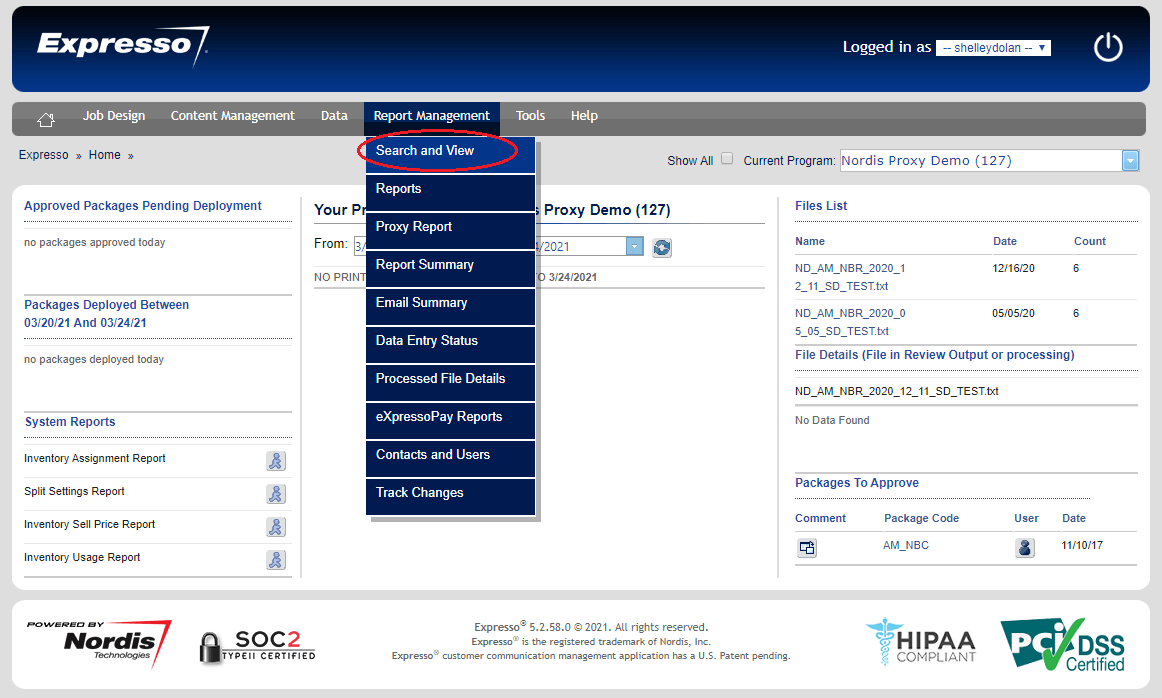Customer communications developed in Expresso® live on to serve multiple purposes after you initially deliver them to customers via print or digital channels. Typical uses for statements, payment confirmations, HOA governance materials and other documents include:
- Generating communications trend reports
- Answering customer questions
- Remailing or emailing duplicate copies
- Long-term retention to meet regulatory requirements
- Supporting customer self-service via a portal
Expresso makes it fast, easy and convenient for businesses to find, use, compile and store these documents. You can choose or change which features and tools work best for you to manage and retrieve documents, from APIs to PDF return files and/or Expresso’s built-in Search and View functionality.
Store
Nordis automatically archives Expresso-created documents for 90 days. Clients often extend the archive period to suit their needs, with some clients requiring up to seven years for compliance communications such as adverse action letters compared to billing statements which are most often preserved for 12-24 months. The archive period determines how long the records are instantly available for customer service, reporting and presentment in payment portals, mobile apps, websites and customer relationship management systems. The archive period also determines how long the documents are available through search and view and/or Expresso reporting.
Collections firms often keep records in the Expresso archive for several years. Others extend the standard archive period to one year while also having the records sent to them as PDF files. The companies then store the records on their computer systems for long-term retention. In these circumstances, they have the records if needed but generally can’t quickly search and access them.
Product Showcase: Expresso’s Communications Archive Improves Customer Service and Compliance
Retrieve
Expresso’s Search and View feature lets clients quickly locate documents. Search and View is located on the drop-down menu for Report Management on Expresso’s dashboard.

During your initial Expresso configuration, businesses define which data fields should be indexed for search and view purposes (e.g. customer name, account number, etc.). Then users can use these fields within the archive period to immediately retrieve in real time any email, text or paper document created in Expresso that was sent to a particular customer or account number.
There are two main ways to access Search and View. Call centers, customer service representatives and other authorized users can easily toggle from their core system to log on to Expresso to do a quick search. This feature comes in handy for mid-sized clients, especially for specially trained agents that get involved if a customer issue is escalated. An added benefit is the ability to re-mail or email the document directly from Search and View.
Alternatively, clients can access archived communications as needed using Expresso’s standard API through which the documents are fed directly into their customer service system of record. Large enterprises with hundreds of agents find it more efficient to connect via API between Nordis and their main system so that agents can work from one unified system.
Expresso Tips & Tricks: Using Search and View in your Expresso CCM Platform
Present
Being able to instantly present a letter, bill or other customer communication, rendered in PDF exactly as the original, is a popular capability for self-service online account management. Expresso uses standard APIs that enable customers to trigger presentment of their documents from Expresso to client payment portals and other sites. For companies using both Expresso and ExpressoPay for electronic bill presentment and payments, instant presentment via API is built in. In either case, monthly statements are typically preserved and presented for at least 12 months allowing customers to access these documents in real time, thus helping reduce customer phone calls (and associated cost) into the contact center.
Expresso Tips & Tricks: Use APIs to Add Customer Value and Efficiency
Do-It-Yourself
Most clients prefer to use Nordis’ archive, retrieval and presentment capabilities. However, some clients want to immediately transfer their customer documents after they are created in Expresso.
Expresso makes the transfer of documents simple. Clients can receive automated PDF return files, which consist of PDF versions of the documents created and delivered through Expresso. The return files are sent automatically after a file is processed. The client then imports the customer communications into their own systems for long-term retention and presentment purposes.
If you’d like to discuss how to make the most of these features, we can help. Please contact us.
